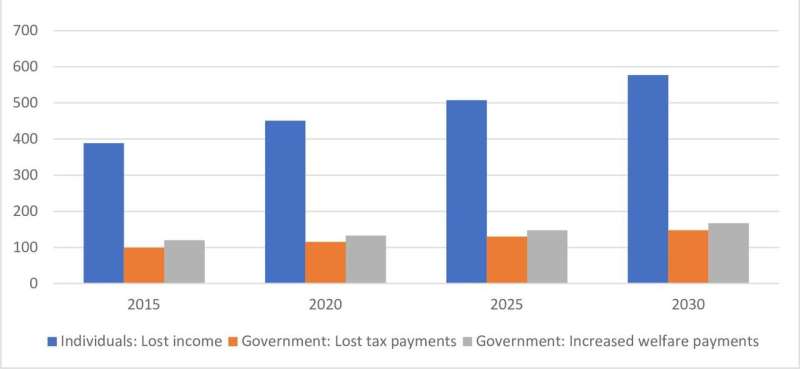This article has been reviewed according to Science X's editorial process and policies. Editors have highlighted the following attributes while ensuring the content's credibility:
fact-checked
peer-reviewed publication
trusted source
proofread
People who care for loved ones with arthritis carry an economic burden

Informal caregivers looking after a loved one with arthritis are financially worse off than non-caregivers to the sum of $388 million, Griffith University research has discovered.
That figure is set to increase to $576.9 million by 2030, painting a stark future for informal caregivers who are not in the labor force and do not receive any monetary compensation in exchange for the care provided.
Informal caregivers are also less likely to participate in the workforce due to the demands of their caregiving duties.
Professor Lennert Veerman from Griffith's School of Medicine and Dentistry co-authored a paper with researchers from Macquarie University which assessed the economic burdens associated with increasing numbers of Australians living with chronic disease—arthritis.
The paper, "Economic impact of informal caring for a person with arthritis in Australia from 2015 to 2030: a microsimulation approach using national survey data," has been published in BMJ Open.
Arthritis, a musculoskeletal disease, can be a costly disease to treat due to its high prevalence and the lifelong nature of the illness.
Professor Veerman said the purpose of the research set out to forecast the economic losses related to caring for people with arthritis from 2015 to 2030.
"People caring for someone with arthritis earn about $1,000 per week less than similar people who do not have caring responsibilities," he said.
"Unfortunately, that figure is projected to increase by 22% by 2030, placing a greater economic impact on informal caregivers.
"This equates to a total economic loss of around half a billion dollars per year, and reduced tax revenue is about $100 million a year.
"This is further proof that our informal caregivers are economically worse off than employed non-caregivers, especially when the future economic impact of informal caregivers is projected to increase."
The paper has prompted researchers to encourage decision-makers to increase the effort to not only prevent the chronic disease, but also improve quality of life and improve economic growth.
More information: Deborah J Schofield et al, Economic impact of informal caring for a person with arthritis in Australia from 2015 to 2030: a microsimulation approach using national survey data, BMJ Open (2024). DOI: 10.1136/bmjopen-2023-076966





















